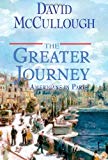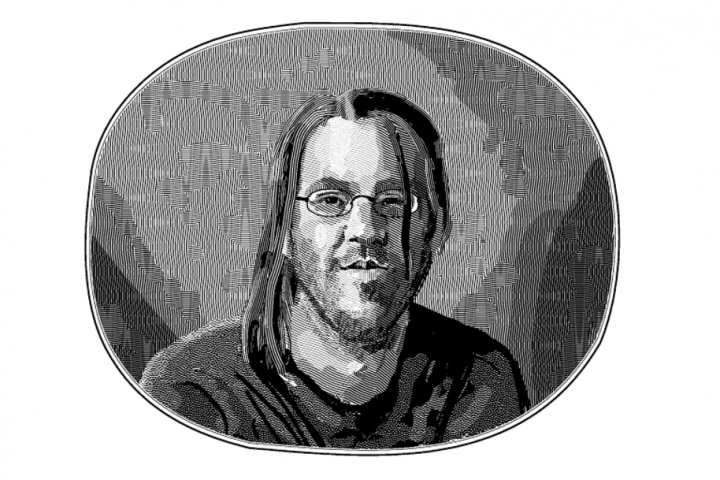Books Reviewed
A review of The Greater Journey: Americans in Paris , by David McCullough
, by David McCullough
It has been well said that the French go to London to work while the British go to Paris to spend. David McCullough, whose nine previous books include histories of the Brooklyn Bridge and Panama Canal as well as biographies of John Adams and Harry Truman, does not try to extract a similar pithy generalization in The Greater Journey: Americans in Paris. Instead, this wonderful book casts a very wide net, covering the experiences of American students, scientists, inventors, politicians, diplomats, idlers, artists, and others who came to Paris between the advent of the self-styled "bourgeois monarchy" of Louis Philippe in 1830 and the end of the century. Greater Journey is organized around chapters focusing on either single figures like Mary Cassatt, James Fenimore Cooper, Samuel Morse, George Healy, and Augustus Saint-Gaudens, or groups defined by pursuits like art or medicine. Like any good travel writer, McCullough uses the experiences of his countrymen in a foreign land to tell his American readers new things about themselves.
At its core Greater Journey is concerned with the theme of education. Whether it is Oliver Wendell Holmes, Sr., a medical student observing the sick with the professors of medicine of the École de Médecine, or Samuel Morse laboriously copying the Renaissance masters in the Louvre, McCullough's Americans go to Paris to further their education. If they are already accomplished in their craft they go, as did James Fenimore Cooper, in pursuit of still higher achievement.
The German idea of Bildung suits these pioneers of study abroad, who took, however, a distinctly American approach to spiritual expansion, elevation, and integration. Of the Americans profiled here few express or exemplify the view, which became popular only later, that education should involve discarding one's American identity in order to embrace a more refined foreign one. McCullough's 19th century Americans seek instead a kind of education to help them as Americans, to rarify and complete their Americanness, often in contrast to the Frenchness of the French. They don't leave America to find the world, but like Mark Twain's eponymous hero in The Innocents Abroad, travel the world to find America.
Study abroad is supposed to be fun, not just earnest, of course. McCullough explores the Paris of P.T. Barnum, whose Broadway Circus highlights were such a great sensation on the Right Bank in 1845 that Louis Philippe, the "pro-American" king who in his youth had been a waiter in a Boston oyster house, brought Barnum's group in for a private showing. McCullough reports, too, how a 15-year-old Creole pianist from New Orleans named Louis Gottschalk became the first American to conquer the Parisian stage, performing Chopin for Chopin.
* * *
But over and above the lighter side of Parisian life, Greater Journey raises the serious question of the sort of education fitting for an American. This issue is especially prominent in the first and better half of McCullough's work, which concerns the travelers in the first part of the 19th century. In the second half, he treats the later decades of the century when the trickle of American visitors to Paris became a veritable flood, and when the city became more comfortable and modern. While the second half does include some excellent parts (especially his discussion of Elihu Washburne, American ambassador to France during the Franco-Prussian War), McCullough stumbles a bit when forced to deal with such a throng. In the 1830s, by contrast, there were only around a thousand Americans inhabiting a Paris that still retained many medieval characteristics. With Haussmann's grand boulevards yet to be designed or constructed, much public life took place in narrow streets and courtyards. There was still some Latin in the Latin Quarter, and widespread poverty. Nonetheless, this was already a city whose sheer scale was unlike anything in America, with 800,000 residents in 1830, compared to New York's 200,000 or Boston's 60,000.
Paris afforded visiting Americans unequalled exposure to the classics, which were prized but inaccessible in the New World. For the aspiring artist, no city offered comparable access to masterworks, high-level instruction, and a public eager to reward artistic achievement. With few formal requirements, classes on any subject anywhere in the city opened their doors to foreign students. Outside the classroom, they could observe the comedy of manners provided by a declining but residually aristocratic society.
* * *
If the opportunities were great, so too, the Americans believed, were the perils. Many young visitors worried about dissipation, and tried to fortify themselves against it. In sight of France on the English Channel in 1837, the 26-year-old Charles Sumner prayed to return home "untainted by the immoralities" he would encounter abroad. Monarchy itself, notwithstanding its strange liberal features under Louis Philippe, struck many visitors as the fundamental Old World immorality.
Americans in Paris in the early 1830s frequently made pilgrimages to see "Old General Lafayette," one of the last living statesmen of the War of Independence. Jefferson and Adams, well known in and to Paris, had died only a few years earlier. The American Revolution would henceforth have to be perpetuated by memories and ideas rather than physical ties. As Harry V. Jaffa has argued, it can be more difficult to maintain a revolutionary heritage than to make a revolution. Many of the visitors had a keen sense of their intellectual and political responsibilities in America, which made them irreverent or simply defiant when addressing feckless counterparts in France: "An American gentleman is equal to any title or rank in Europe, kings and emperors not excepted," wrote the painter turned telegraph code inventor Samuel Morse, which pretty much sums up the insouciant attitude of Americans with respect to the contemporary exemplars of French culture. Their attitude towards the classics, however, was altogether different.
The challenge, then, was to take advantage of the great resources of Paris while maintaining what James Fenimore Cooper called "republican simplicity." An austere bearing was one way to profit from the experience without being corrupted by it. Americans rejected moustaches and other signs of dandyism. But the most effective response, as McCullough shows, was devotion to work. Morse copied great paintings at the Louvre throughout the deadly cholera epidemic of 1832. The daily routines of the serious art and medical students left them only a little time for theatre and diversions, and even less for the debauchery feared by their folks back home.
The Gallery of the Louvre, the large painting by Morse, deliberately tried to capture the proper American attitude. The painting features Morse, the Cooper family, and other American artists in a gallery filled to the ceiling with great European masterpieces. Among the living characters in the room, however, there are few Frenchmen and no other Europeans. Americans were to be grateful for the masterworks and cultural heritage of the Old World, without forgetting that they were a new people who had sailed across the Atlantic to escape European quarrels and persecutions. Learn from Europe, Morse's painting advised, but do not forget your destiny.
John Sanderson, a Philadelphia teacher and writer, was amazed by the art in Paris, noting that there was nothing comparable in America—yet. Sanderson and his fellows shared none of the pessimism expressed by certain visitors to America about the prospects for American art. On the contrary, their great hopes spurred their diligence. Soon the results were impressive—George Healy's political paintings (such as Webster's Reply to Hayne), his portraits (e.g., the young Lincoln), and Augustus Saint-Gaudens's sculptures (like his Farragut in New York City). These works celebrated American heroes and inspired Americans to emulate them.
* * *
Academic science was another source of inspiration to the Americans. In the 1830s and '40s Parisian resources for medical education were without equal. In 1833 the city's twelve hospitals treated 65,000 patients, while the two in Boston saw fewer than 800. Medical education in the U.S. still worked on an apprenticeship model, which hardly permitted exposure to the diverse ailments and conditions the modern doctor would be required to treat. Moreover, physicians in the States disdained textbook learning or any theoretical inquiry into ailments. Their frontier empiricism could guard against certain medical extravagances, but genuine theoretical knowledge of disease remained in a low state.
By contrast, in Paris the students were treated to a vast array of medical knowledge, from lectures to the famed "walkabouts"—strolls around Parisian hospitals with eminent professors of medicine observing every conceivable malady. Of the superstar medical professors, the most popular was Pierre Charles-Alexandre-Louis, an expert on tuberculosis who had a no-nonsense approach, insisting on evidence. Louis took a distinct interest in the Americans, and under his tutelage many of them flourished—not by aping the French approach but by thinking it through and comparing it to American practices. Even as they benefited from learning abstract ideas about diseases, American practitioners noted with dismay how this approach could easily lead to theorizing medicine while neglecting patients. Oliver Wendell Holmes, Sr., perhaps the most famous of some 700 Americans who McCullough says studied medicine in Paris between 1830 and 1860, criticized Louis, less a showman and artiste than many of his colleagues, for sometimes being more interested in observing and describing the characteristics of a disease than actually restoring an afflicted patient's health. The Americans were not to fall into this trap.
* * *
By the middle of the 19th century, Paris had already become what Churchill would call in Thoughts and Adventures "that amazing composite entity." Simultaneously modern and ancient, the metropolis offered anonymity and freedom, foppishness and genuine taste. Guided by their principles and experiences, Americans learned some of the best lessons the Old World could teach, but did so in the service of an experiment in self-government that was decidedly new. In showing how old wisdom was brought to bear on new realities, David McCullough provides inspiration for those grappling with that experiment today.





